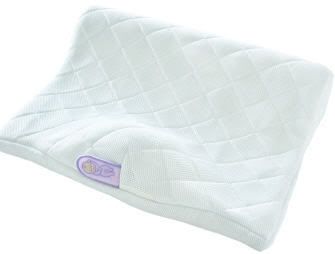
Back to sleep.
That's the way I was taught to always remember that a child must be placed facing upward when lying down. It's a simple statement that carries a powerful meaning. However, because children are now constantly sleeping in this position, another concern has arisen - Positional Plagiocephaly.
According to Dr. Ricardo Hahn,
"Positional Plagiocephaly occurs when an infant's head is flattened from lying in the same position for too long. Because baby's heads are soft to allow for rapid growth in their first year of life, their skull is susceptible to direct pressure from beds, cribs, strollers, carseats, etc. that force the bones to shift in a certain direction. It usually occurs in the first 8-12 weeks after birth."

To help prevent this, the Symmetry Sleep System positions your child on their back in such a way that their head rests gently to the side. The simple sleep indicator then reminds you to alternate the position of your child each time you lay them down to maintain equal pressure on the developing skull. Also included is a specially designed caliper to monitor the symmetry of your child's head.
I was sent a system to review but had no one to try it out on. So I decided to give it to my SIL since she recently had a baby boy. The main thing she liked about this system is that it was comfortable. After all, if the baby refuses to sleep in it, then what's the point? The sleep indicator was also a plus because when you're trying to function on minimal sleep, you need all the reminders you can get.
The Symmetry Sleep System was released late 2007 and can be purchased at Toys-R-Us for $79.99.
If you'd like more information on Positional Plagiocephaly, please view the following Q&A with Dr. Richard Hahn. If you have more questions, please feel free to email me and I'll make sure he receives them.
How can I tell if my baby is suffering from Positional Plagiocephaly? Usually, the back of the baby's head, on the side will be noticeably flat. The ear on the flattened side may be pushed forward or the ears will be asymmetrical. A parent-friendly caliper can be used to measure the symmetry of baby's head.
What is Flat-Head Syndrome?
Flat-Head or Flattened-Head syndrome is just another name for the condition.
What causes Plagiocephaly?
The most common cause of Plagiocephaly is a baby's sleep position, caused by the long hours they spend lying on their back. Premature babies are more prone to Plagiocephaly because of their extremely soft skulls. Plagiocephaly can also develop in babies with neck muscles that are too tight (torticous) or before birth from pressure in the mother's womb.
Why have the incidences of Plagiocephaly increased?
Doctors have noticed an alarming increase of cases of Plagiocephaly in the past 15 years. This increase coincides with the American Academy of Pediatrics (AAP) “Back to Sleep” campaign advocating that babies sleep on their backs to prevent SIDS. Although the 1992 “Back to Sleep” campaign has increased the incidence of flat head syndrome, the prevention of SIDS is still the top concern and by teaching the right prevention methods, Plagiocephaly too, can be prevented.
What can I do to prevent my baby from developing Plagiocephaly?
In addition to continuously repositioning your baby using the TOTS method (tummy time, opposite side of the crib, turn your baby's head and switch arms) Dr. Plagio, a leading family physician, of the Keck School of Medicine at the University of Southern California has partnered with Basic Comfort, the leading expert in sleep aides to bring to fruition the Symmetry Sleep System. This clinically designed sleep positioner prevents Plagiocephaly by taking the pressure off an infant’s skull while also providing a reminder system for parents to keep track of baby's sleep position.
Can the Symmetry Sleep System be used in harmony with the “Back to Sleep” campaign?
Yes. While preventing Plagiocephaly, the Symmetry Sleep System works in conjunction with SIDS prevention by preventing baby from rolling onto its stomach and also keeps baby's airways unobstructed.
How did the Symmetry Sleep System come about?
The Symmetry Sleep System is the result of three intense years of investigation and development conducted by the University of Southern California and Dr. Plagio. The Symmetry Sleep System was prototyped and patented by the Alfred E. Mann Institute for Biomedical Engineering with the six-fold increase in cases of Plagiocephaly since 1992. Dr. Plagio decided to partner with the leading expert in infant sleep aids to bring back the number of case to pre-1992 levels. While there are corrective measures available, many of them are extremely expensive and may not always be covered by insurance companies.
Does Plagiocephaly go away naturally?
Sometimes. In some cases Plagiocephaly does go away naturally, but without some sort of intervention there can be permanent medical damage. Some cases of Plagiocephaly do not correct themselves, even when found early. Correction might require the use of a very expensive helmet, even which might not prevent cases of facial abnormalities, problems with chewing, eating and vision.
Is Plagiocephaly mainly a cosmetic issue?
No. Although some physicians believe that Plagiocephaly is a self-correcting condition and concentrate only on SIDS prevention, cases of facial abnormalities, problems with chewing, eating and vision may occur without early intervention.
What treatment options are available for Plagiocephaly?
The best treatment is PREVENTION. The TOTS recommendation and the Symmetry Sleep System can be used to prevent Plagiocephaly before corrective treatments are needed. Corrective treatments usually involve a helmet to reshape the head BUT these devices are very expensive and may not always correct the deformity. To add insult to injury, many insurance companies refuse to pay for these treatments saying they are purely cosmetic.
 As a flight attendant, one of the most common questions I receive from traveling families besides "Do you have extra diapers on board?" is "Have you ever heard of the CARES Restraint System? Is it really that easy?"
As a flight attendant, one of the most common questions I receive from traveling families besides "Do you have extra diapers on board?" is "Have you ever heard of the CARES Restraint System? Is it really that easy?"













